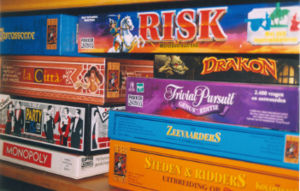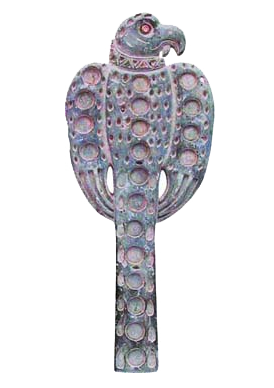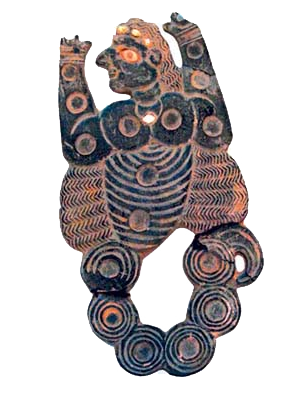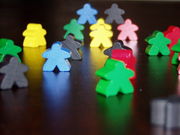Board game
2008/9 Schools Wikipedia Selection. Related subjects: Games

A board game is a game in which counters or pieces that are placed on, removed from, or moved across a "board" (a premarked surface, usually specific to that game). Like any other form of entertainment, board games can represent nearly any subject. However, most well-known mass-market board games are generally simple all ages family entertainment. Most celebrated board games, such as chess, go/weiqi, xiangqi, shogi, or oware, have been classics for centuries, and are considered to have intense strategic depth.
There are many different types of board games. As the term denotes a type or form of game, rather than a genre, there is a wide range of different styles of board games. At the most basic level, they can be broken down by games that have no inherent theme (but could still be 'about' something) and those with a definite subject, or even story; compare checkers with Cluedo/Clue. Otherwise, games are often broken down by an arbitrary mix of game mechanics and subject matter.
History
Board games have been played in most cultures and societies throughout history; some even pre-date literacy skill development in the earliest civilizations. A number of important historical sites, artifacts and documents exist which shed light on early board games. Some of these include:
- The Jiroft civilization Game Boards
- Senet has been found in Predynastic and First Dynasty burials of Egypt, c. 3500 BC and 3100 BC respectively. Senet is the oldest board game known to have existed, having been pictured in a fresco found in Merknera's tomb ( 3300- 2700 BC).
- Mehen is another ancient board game from Predynastic Egypt.
- Go is an ancient strategic board game originating in China
- Patolli is a board game originating in mesoamerica and played by the ancient mayans.
- The Royal Tombs of Ur contained, among others, the Royal Game of Ur. They were excavated by Leonard Woolley, but his books document little on the games found. Most of the games he excavated are now housed in the British Museum in London.
- Buddha games list is the earliest known list of games.
Timeline
- c. 3500 BC - Jiroft civilization The lay-out of the "holes" on the "eagle" boards is also identical to the lay-out of some twenty squares boards used in ancient Egypt, where the game, known as "Aseb," was sometimes put on the other side of case-style Senet boards.
- c. 3500 BC - Senet found under Predynastic Egyptian burials; also depicted in the tomb of Merknera.
- c. 3000 BC - Mehen, board game from Predynastic Egypt, played with lion-shaped game pieces and marbles.
- c. 3000 BC - Ancient backgammon set, found in the Burnt City in Iran
- c. 2560 BC - Board of the Royal Game of Ur (found at Ur Tombs)
- c. 2500 BC - Paintings of senet and han being played made in the tomb of Rashepes
- c. 2000 BC - Drawing in a tomb at Benihassan depicting two unknown board games being played (depicted in Falkner). It has been suggested that the second of these is tau.
- c. 1500 BC - Liubo carved on slab of blue stone. Also painting of board game of Knossos.
- c. 1400 BC - Game boards including alquerque, three men's morris, nine men's morris, and a possible mancala board etched on the roof of the Kurna temple. (Source: Fiske, and Bell)
- 548 BC The earliest written references to Go/Weiqi come from the Zuo Zhuan, which describes a man who likes the game.
- c. 500 BC - The Buddha games list mentions board games played on 8 or 10 rows.
- c. 500 BC - The earliest reference to Chaturaji or Pachisi written in the Mahabharata.
- c. 200 BC - A Chinese Go/Weiqi board pre-dating 200 BC was found in 1954 in Wangdu County. This board is now in Beijing Historical Museum..
- 116-27 BC - Marcus Terentius Varro's Lingua Latina X (II, par. 20) contains earliest known reference to latrunculi (often confused with ludus duodecim scriptorum, Ovid's game mentioned below).
- 1 BC-8 AD - Ovid's Ars Amatoria contains earliest known reference to ludus duodecim scriptorum and the smaller merels.
- 220-265 - Nard enters China under the name t'shu-p'u (Source: Hun Tsun Sii).
- c. 400 onwards - Tafl games played in Northern Europe.
- c. 600 The earliest references to Chaturanga written in Subandhu's Vasavadatta and Banabhatta's Harsha Charitha
- c. 600 - The earliest reference to Chatrang written in Karnamak-i-Artakhshatr-i-Papakan.
Board games first became widely popular among the general population early in the 20th century when the rise of the middle class with disposable income and leisure time made them a receptive audience to such games. This popularity expanded after the Second World War, a period from which many classic board games date.
Many board games are now available as computer games, including the option to have the computer act as an opponent; and many acclaimed computer games such as Civilization were originally based upon board games. The rise of computers has also led to a relative decline in the most complicated board games, as computers require less space, and the games don't have to be set up and cleared away. With the Internet, many board games can now be played online against a computer or other players. Some web sites allow play in real time and immediately show the opponent's moves, while most use e-mail to notify the players after each move (see the links at the end of this article).
Some board games make use of additional components, aside from the board and playing pieces. Some games use CDs, video cassettes and more recently DVDs to provide an accompaniment to the game. A genre of DVD games makes use of the interactive features of DVDs, often to provide a "quizmaster" for trivia games.
The modern board game industry is rife with corporate mergers and acquisitions, with large companies such as Hasbro owning many subsidiaries and selling products under a variety of brand names. It is difficult to successfully market a new board game to the mass market. Retailers tend to be conservative about stocking games of untested popularity, and most large board game companies have established criteria that a game must meet in order to be produced. If, for instance, Monopoly were introduced as a new game today, it might not meet the criteria for production.
Psychology
While there has been fair amount of scientific research on the psychology of traditional board games (e.g., chess, Go, mancala games), much less has been done on more recent board games such as Monopoly, Scrabble, or Risk.. Most of the research has been carried out on chess, in part because chessplayers are ranked in national and international rating lists, which makes it possible to compare their level of expertise precisely. The classical works of Adriaan de Groot, William Chase and Herbert Simon have established that knowledge plays an essential role in chessplaying, more than the ability to anticipate moves. This seems to be the case in other traditional games such as Go and oware (a type of mancala game), but data are lacking with more recent board games.
Common terms
Although many board games have a jargon all their own, there is a generalized terminology to describe concepts applicable to basic game mechanics and attributes common to nearly all board games.
- Game board (or board)—the (usually quadrilateral) surface on which one plays a board game; the namesake of the board game, gameboards are a necessary and sufficient condition of the genre.
- Game piece (or token or bit)—a player's representative on the game board. Each player may control one or more game pieces. In some games that involve commanding multiple game pieces, such as chess, certain pieces have unique designations and capabilities within the parameters of the game; in others, such as Go, all pieces controlled by a player have the same essential capabilities. In some games, pieces may not represent or belong to a particular player.
- Jump—to bypass one or more game pieces and/or spaces. Depending on the context, jumping may also involve capturing or conquering an opponent's game piece. (See also: Game mechanic: capture)
- Space (or square)—a physical unit of progress on a gameboard delimited by a distinct border. (See also: Game mechanic: Movement)
- Hex In hexagon-based board games, this is the common term for a standard space on the board. This is most often used in war games.



